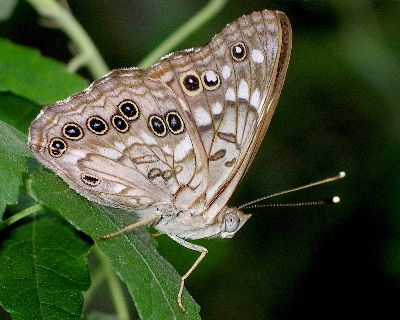by Valerie
June, 2006Hackberry Emperor Although it is not spectacularly colored, the hackberry emperor (Asterocampa celtis) is one of the more entertaining butterflies that frequent our yard. Named for the larval food, hackberry tree foliage, this butterfly is a medium-sized brown insect that is most common during late summer and autumn. About that time, there is often at least one male emperor that chooses the central part of our backyard for his territory. Males can be distinguished from females by the shape of the lower wings and overall size. Females are larger and their wings are very rounded while those of the smaller male are more triangular. The insect shown above is a male. Adult emperors are more likely to be seen feeding on rotting fruit (frequently in our compost bins) or leaking tree sap than on flowers. Hackberry emperors are members of a group called the brush-footed butterflies. It appears that the individual in the illustration has only four legs. In actuality, the first pair of legs are very tiny and are held up close to the body. They are covered with hair-like structures that function as chemical receptors, much the same as the antennae of moths. Once a male chooses a territory, he defends it with most un-butterfly-like aggression. More than once, I've had a hackberry emperor fly at me, hitting me in the head or neck. They seem to be especially partial to objects that enter their "airspace" at 5-6 feet off the ground. While they will ignore our dog running down near the ground, a ball thrown at the appropriate height elicits a reaction. When not darting about in flight, the emperor usually perches where there is a good view of intruders or approaching females. |